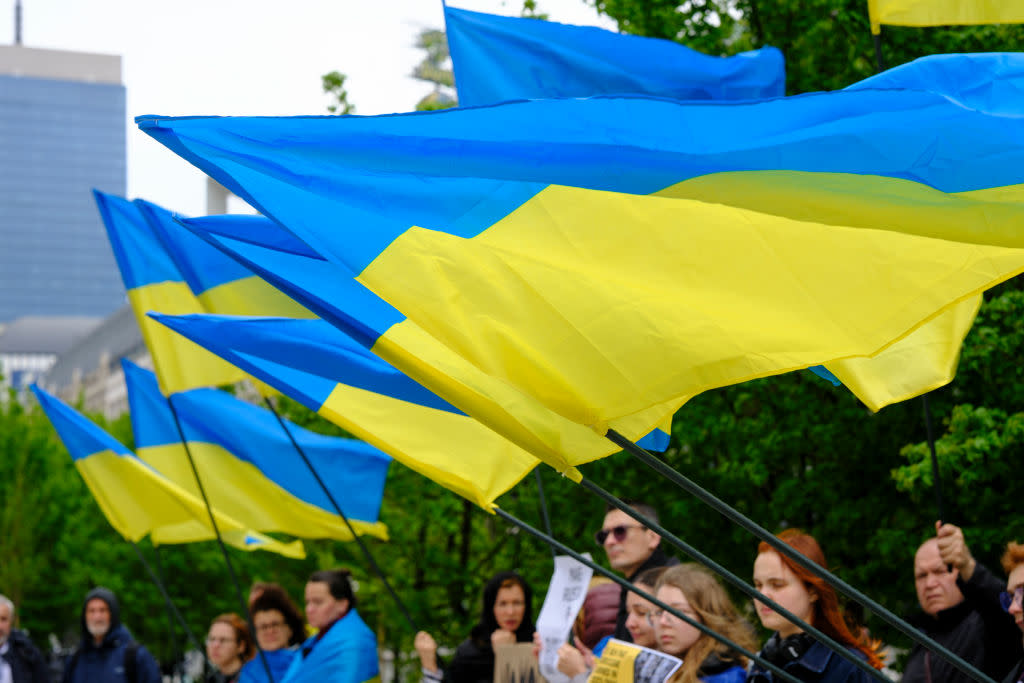It's Time to Direct Russia's Frozen Assets to Ukraine

- Oops!Something went wrong.Please try again later.
Ukrainians from the diaspora demonstrate in front of the Belgium-based financial services company Euroclear to advocate for Western nations to seize the frozen assets of the Central Bank of the Russian Federation on April 11, 2024 in Brussels, Belgium. Credit - Thierry Monasse/Getty Images
Recent battlefield reverses in Ukraine, with Kherson under increasing attack, are powerful reminders that Ukraine needs every penny of support it can get urgently. Yet Western governments still refuse to seize Russia’s $300 billion in frozen assets, even though the idea of making Russia pay for Ukraine’s rebuilding is broadly popular across the U.S.—with even House Speaker Mike Johnson embracing it as “pure poetry.”
Initially, many officials resisted this move under the haze of a vague unspecified conflict with international law, but those arguments dissolved after Harvard Professor Laurence Tribe published a compelling 199 page legal treatise on why international law supports seizing Russia’s frozen assets, winning the endorsements of hundreds of top international law scholars across the world as well as leading economic, diplomatic, and policy voices including Lawrence Summers, Phillip Zelikow, and Robert Zoellick.
Congress’ passage of the Repo Act giving the President the power to unilaterally confiscate frozen Russian sovereign assets last month, alongside $95 billion in long-delayed military support, removed any final legal obstacles standing in the way. Since then, U.S. Deputy National Security Advisor Daleep Singh has been pushing hard as the point-person on seizing Russian assets, with seemingly little help from his superiors in the Biden Administration, and finding little enthusiasm in the G7 outside of Canada and the U.K. And despite the U.S.’ commitment to giving wide berth to European allies, most are lukewarm if not downright hostile to the idea.
Read More: How to Make Russia Pay to Rebuild Ukraine
The compromise solution the G7 countries seem to have landed on is highly unsatisfactory. Any day now, the E.U. is expected to formally adopt a plan to use the interest income on frozen Russian assets to fund Ukraine, with the G7’s endorsement. The problem, however, is that the roughly $5 billion in interest income amounts to a few weeks’ worth of Ukrainian military spending, hardly enough to move the needle.
Singh has pushed back by suggesting a loan backed by about 10 years’ worth of interest income, equivalent to about $60 billion. While this is a commendable first step, and far superior to the the E.U.’s original, it is still no substitute for going after the whole $300 billion.
European officials readily admit that international law does not stand in the way of seizing these frozen assets. Rather, their key concerns are much more mundane and political in nature—namely, the impact of such a move on the euro’s status as a reserve currency, the impact on Europe’s abilities to attract future global capital flows, and the disproportionate burden borne by Europe relative to the U.S., as encapsulated by European Central Bank chair Christine Lagarde.
These concerns are dramatically overstated, as hundreds of leading economic and governmental voices have affirmed. Simply put, seizing Russian’s assets will hardly trigger financial crises or economic disasters. Foreign investors have few viable reserve currencies to turn to outside of the U.S. dollar and euro, with even the Chinese renminbi still subject to strict capital controls, meaning the seizure of Russian assets will hardly have any impact on Europe’s ability to attract and retain capital flows. And global business and financial leaders overwhelmingly recognize the one-off nature of Russia’s invasion of Ukraine, so the seizure of Russian assets would not set off any chain reaction.
We simply cannot afford to aim too low in the seizure of Russian assets. The World Bank estimates that damages to Ukraine now conservatively exceed $500 billion. Even beyond the fact that there is no other economically and politically viable pathway toward coming close to funding Ukraine’s daunting reconstruction needs beyond the frozen Russian assets, the costs of rebuilding Ukraine should be borne by reparations from the aggressor who initiated this bloody war, not by innocent U.S. or European taxpayers. And the ongoing attacks on Ukrainian infrastructure and its energy grid are powerful reminders that economic reconstruction in Ukraine does not begin after the war ends: rather, it continues everyday, as an integral part of Ukraine’s fight for survival.
As Harvard’s Tribe previously remarked, “there can be no justification for halfway measures, let alone for doing nothing while Ukraine is destroyed. Inaction is an illusion: it would represent a cowardly decision to appease and to encourage further aggression around the world.” Similarly, 80 years ago, FDR warned, “The only limit to our realization of tomorrow will be our doubts of today.”
The time to act to seize Russia’s $300 billion in frozen assets is now.
Contact us at letters@time.com.

